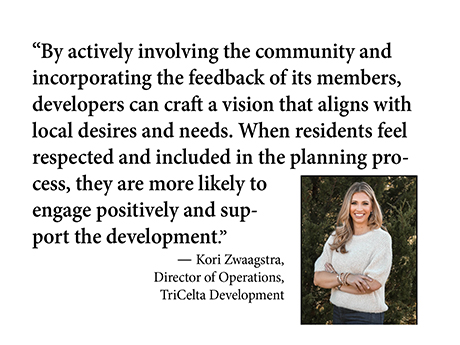By Kori Zwaagstra, director of operations, TriCelta Development
As the commercial real estate market continues to evolve in unexpected ways, the key to making a project truly impactful lies in strong community involvement from the beginning.
With shifting trends and economic ups and downs, developers benefit from listening to the people who will be most affected. By working closely with residents, city officials and underrepresented groups, developers can create projects that feel more connected, sustainable and widely accepted. This approach not only streamlines the development process but also preserves projects’ relevance and adaptability to market changes — all while keeping the community’s needs front and center.
Understanding Stakeholders’ Impacts
Stakeholders are more than people with financial interests in a project — they also include the end-users who will experience the space firsthand.
These are the individuals who will live, work and interact with the development daily, and their perspectives impact the project’s success. Prioritizing community needs and incorporating feedback ensures that the project aligns with expectations. The goal is to create a development that benefits both investors and the community, achieving a balance that enriches the lives of everyone involved.

While immediate financial gains and the needs of primary owners are important, emphasizing long-term community benefits is crucial for a project’s overall impact. Involving contractors early in the design phase — rather than waiting until later stages — facilitates alignment with community expectations and needs. This approach fosters collaboration among all stakeholders, supporting effective budget and schedule management while allowing the design team to address community priorities.
At TriCelta Development, we believe engaging with the community early and planning thoughtfully can prevent costly budget overruns for owners and boost the project’s positive contribution to the neighborhood.
Balancing Municipal Objectives
Municipalities often focus on tax benefits and economic growth, but their objectives may not always align with the needs of local communities.
To bridge this gap, feasibility studies are one of many options for assessing whether a project fits the market’s capacity and demand. Developers should also collaborate with municipalities to understand regulatory constraints and verify that their vision supports the city’s long-term goals.
However, official approvals are just the beginning. Gaining early input from residents is equally important. Hosting community forums allows developers to engage directly with locals and gather valuable feedback. For example, if a developer is looking to build a new entertainment venue in a suburban area, early community involvement can reveal whether residents would prefer entertainment options over additional dining venues or if they need spaces for events and gatherings. This proactive approach helps align projects with community needs and fosters positive reception.
Techniques for Effective Engagement
To ensure that a development truly benefits the community, leveraging surveys or focus groups is highly effective.
In the hospitality industry, for example, surveys provide valuable insights into guest preferences and needs. This feedback extends beyond just the guests to include the needs of operational staff, leading to more effective plans that enhance job satisfaction and community contentment.
Much like casino loyalty programs that use perks and customer relationship management (CRM) systems to boost survey participation, development projects can benefit from engaging with the local population in a similar way. Offering incentives and actively involving residents increases the chances of garnering support for the project. This approach fosters transparency and builds trust, as the community sees how its input is shaping the development to address its concerns, whether it’s reducing traffic congestion or ensuring sufficient hotel accommodations during peak times.
Transparency, Sharing Vision
A vital piece of early community engagement is fostering transparency about the development vision and demonstrating its benefits.
Developers should openly communicate the positive impacts of the project while also addressing potential challenges, such as traffic congestion or environmental concerns. This openness helps the community understand the project’s value and how it complements the neighborhood.
For instance, if a developer proposes an entertainment hub in a suburban area, addressing potential traffic concerns early on by sharing traffic studies or mitigation plans can alleviate worries. By actively involving the community and incorporating the feedback of its members, developers can craft a vision that aligns with local desires and needs. When residents feel respected and included in the planning process, they are more likely to engage positively and support the development.
Building With Purpose, Community Insight
Overall, involving the community early in the development process is essential for creating spaces that truly benefit their users. Utilizing tools such as feasibility studies, surveys and forums allows developers to assess market needs, understand community priorities and incorporate valuable feedback into their designs. Building transparency, especially with underrepresented groups, fosters trust and supports long-term project viability.
By treating the city, community and end-users as integral stakeholders, developers can create projects that are both sustainable and well-integrated into the community. The approach of aligning design, budget and community vision exemplifies a thoughtful development process that addresses the needs and interests of all involved parties.


